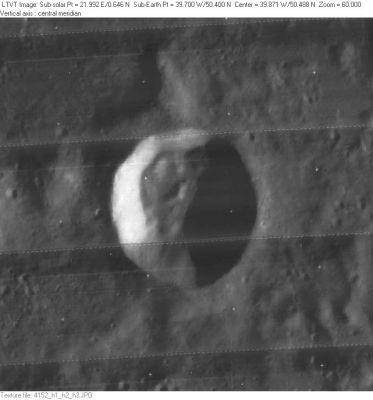Foucault
Contents
Foucault
|
Lat: 50.4°N, Long: 39.7°W, Diam: 23 km, Depth: 3.4 km, Rükl: 2, Upper Imbrian |
LO-IV-152H The isolated peak to the west of Foucault was once known as Foucault Gamma, the larger boomerang-shaped one to the north has never been named.
Images
LPOD Photo Gallery Lunar Orbiter Images Apollo Images
Maps
(LAC zone 11D3) LAC map Geologic map
Description
Description: Elger
(IAU Directions) FOUCAULT.--A bright deep ring-plain, about 10 miles in diameter, lying W. of the mountains fringing the Sinus Iridum, between Bianchini and Harpalus. A very lofty peak rises near its N. border, and, according to Neison, it has a distinct central mountain, though neither Madler or Schmidt show any detail within.
Description: Wikipedia
Additional Information
- Depth data from Kurt Fisher database
- Westfall, 2000: 3.4 km
- Viscardy, 1985: 2.1 km
- The shadows in LO-IV-152H indicate that at its highest point the east rim is about 3,300 m above the floor. - Jim Mosher
- TSI = 15, CPI = 10, FI = 20; MI =45 Smith and Sanchez, 1973
Nomenclature
- Named for Leon Foucault (1819-1868), a French physicist.
- According to Whitaker (p. 221), this name was added by Birt and Lee.
Montes Foucault
- In the Lunar II list of the (US) Astronomical League, "the mountains just west and north of Foucault crater" are Target 44, and referred to as Montes Foucault. This is not, and never has been, an official IAU name. In the original IAU nomenclature of Blagg and Müller, the isolated peak to the north of the crater was Foucault Alpha, the large peak to the west of Foucault was known as Foucault Beta, the dot of a peak between Beta and Foucault was known as Foucault Gamma (Alpha and Beta are outside the field of the Lunar Orbiter image shown above -- see Rükl: 2). These names were dropped in 1973 along with nearly all Greek-lettered peak designations. See also Chart 7 in the Times Atlas of the Moon (although there is no sign of a Foucault Alpha on that chart).
LPOD Articles
Bibliography
